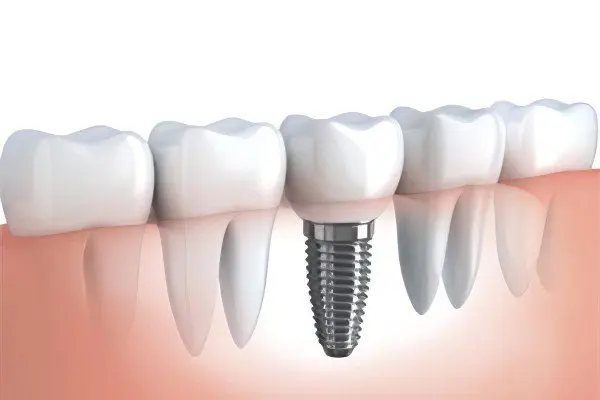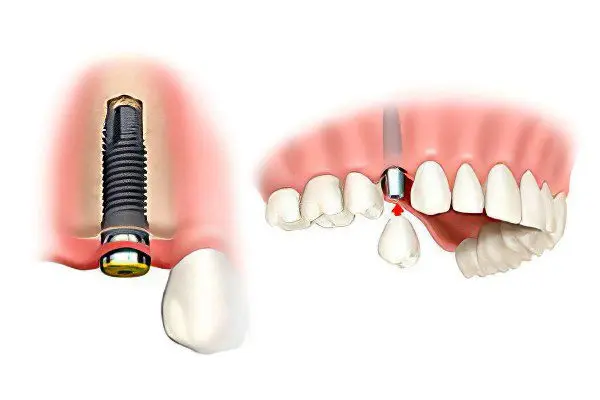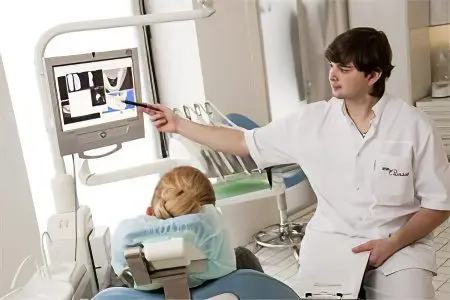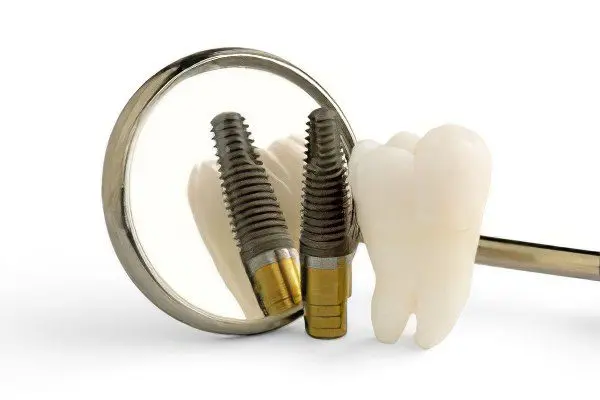Contents

Dental implantation – this is a procedure for implanting implants into the patient’s jaw bone tissue with subsequent prosthetics with crowns, bridges, or conditionally removable dentures. The implant is a pre-prepared artificial structure that is embedded in the jaw tissue for subsequent prosthetics. Implants are designed to replace the roots of lost teeth, which allows you to restore the dentition in the future.
The problem of implantation in modern dentistry remains very relevant. Thus, according to the data provided by WHO, acquired and congenital adentia is one of the most widespread diseases of the dentition and is on a par with caries and periodontal pathologies. Only in Russia, according to various sources, 45-75% of people need orthopedic treatment, and in the world up to 75% of the population suffers from this problem. In recent years, an increasing number of young and mature people suffer from partial adentia.
According to statistics, 86% of patients in dental offices prefer fixed dental structures. It is dental implantation that allows for a fairly predictable success, which has been confirmed by more than two decades of clinical research. After all, implantation itself never acts as a primary therapeutic measure. In this regard, the risk of complications is minimal.
There are many types of dental implants, but they all have an identical structure and consist of a head, neck and body.
Types of dental implants
There are the following types of dental implantation: classical implantation, one-stage implantation, basal implantation and implantation according to the “all-on-4” method. Each of these types of implantation has its own characteristics, advantages and disadvantages.
Classic dental implants
Classical implantation is the most demanded type of implantation among patients. Classical implantation is carried out in two successive stages.
The first stage is surgical. In the subgingival part, directly into the bone, the implant is inserted. When this procedure is completed, the patient will have to wait from 1 month to six months. During this time, the implant will fuse with the bone.
The operation of its introduction is as follows: the mucous membrane of the gums is cut to expose the surface of the bone tissue, after which a hole is made in it for the implant. It is performed using a physiodispenser and special drills. An implant is screwed into the resulting hole, and the cut mucosa is sutured.
During this process, it is important to ensure that the bone is not exposed to too much heat, as this will provoke an inflammatory process (peri-implantitis) and cause the implant to be rejected. To prevent overheating during bone drilling, it is constantly and intensively cooled with saline.
Sometimes the surgical stage of implantation can be extended for another 1 to 6 months. This is required if the bones are of insufficient height or width. This problem is most common in patients who have lost their teeth for a long time ago and is due to bone atrophy without chewing load on it. To correct the situation, the doctor will build up the alveolar process with bone grafting using bone mass (natural or artificial).
The second stage of classical implantation is prosthetics. The mucosa is again cut over the installed implant and a structure is screwed into it, which forms the gum, gives it the desired contour. The healing process takes 14 days. After another 1 week, an abutment will be installed in the implant, then the doctor will make a crown and fix it on it using screwing or using cements.
The advantages of classical implantation are as follows:
Rational approach to the procedure. The phased installation allows the body to adapt to the foreign body, and the rod to securely attach itself to the jaw bone.
The design of the tooth is collapsible, and it is not difficult to replace the crown. This is done easily and does not require removal of the implant.
The teeth adjacent to the implant will not suffer. They do not need to be ground, depulped or polished.
In 99% of cases, the implant itself will serve the patient for the rest of his life. Only the crown or other prostheses fixed on it will need to be changed as necessary.
The load that is applied to the implant is evenly distributed over the entire jaw. In the same way, the load from the natural tooth root would be distributed.
With the help of classical implantation, it is possible to install both a single tooth and all lost teeth.
Both chewing and anterior teeth are subject to restoration.
The disadvantages of classical implantation include:
Long period of time for treatment.
The occurrence of possible difficulties that appear in patients who delay the implantation of the implant for more than 1 month. As mentioned above, atrophy of the bone tissue significantly lengthens the duration of the implantation procedure and leads to certain technological difficulties.
There is a possibility of damage to the appearance of the gums.
The presence of an extensive list of contraindications.
Risk of foreign body rejection.
The high price of the procedure.
Difficult postoperative period with pain, swelling, impaired chewing function.
One-stage dental implantation

One-stage dental implantation is an alternative procedure to the classical method. Its main feature is that the rod will be installed in the bone tissue immediately after tooth extraction. The operation is carried out quickly and in one visit to the dental office, the patient gets rid of an unnecessary tooth and acquires an implant that replaces the diseased root. In this case, it is possible to avoid additional surgical intervention to cut the gums.
One-stage implantation can be performed if the tooth tissues are healthy and the bone tissue of the alveoli is strong.
Advantages of one-stage implantation:
The procedure is minimally invasive.
The recovery period is much less than with classical implantation.
The installation of the tooth is performed in an already prepared hole, so no additional incisions are required.
High doses of anesthesia will not be needed during and after the procedure.
The procedure for removing a tooth and installing an implant takes only a few hours.
Both the implant and the crown will be installed in just one visit to the dentist.
Implants implanted in one step can act as a base for bridges, clasp prostheses and crowns.
Disadvantages of single-stage implantation:
To be able to install the prosthesis, there must be enough space in the gum after the tooth is removed.
Healthy teeth should be located next to the extracted tooth. They will take on the load and allow the implant to take root better.
The risk of rejection of the design exists even after a long time after implant placement.
Due to the fact that the fixation of such an implant is not entirely reliable, there is a risk of its displacement during chewing.
Basal dental implantation
Basal implantation of teeth or express implantation is a rather complicated procedure, during which titanium rods are placed much deeper than in classical implantation. For its implementation, special implants are used, which are implanted in the basal bone of the jaw, and not in its alveolar process. The basal bone lies deeper, it is stronger and does not tend to atrophy. The procedure will take 1 to 5 days to complete.
Due to the special shape of the thread on the implant, a high degree of stability of the implanted structure is guaranteed immediately after its implementation. It is possible to prosthetize such installations after 1-5 days.
The introduction most often passes through a small puncture in the mucous membrane and through a small hole in the bone. There is no need to drill impressive volumes of bone tissue. The special shape of the implants makes it possible to install it even in the case when the bone thickness would not be enough for the classical technology.
The advantages of basal implantation are as follows:
Minimal tissue trauma.
Rapid recovery of chewing ability. The term may be less than a week.
The prosthesis procedure does not require incisions and sutures, which significantly shortens the recovery period.
Since the patient is allowed to chew almost immediately after the operation, the metabolic processes do not have time to slow down. This, in turn, accelerates the survival of the prosthesis.
In the vast majority of cases, there is no need to build up bone tissue in case of its atrophy.
Fewer contraindications for surgery. So the procedure, due to its low invasiveness, can be recommended for people with hepatitis, HIV, diabetes, and elderly patients.
The disadvantages of basal implantation are as follows:
It is recommended to restore at least three teeth in a row using this method. As a rule, one tooth is not restored by the basal technique.
The specialist dentist must undergo additional training in this particular technique of dental implantation.
All – on – 4
All-on-XNUMX is a modern dental implant procedure in which the prosthesis will be supported by only four implants.
Indications for the use of this technique may be:
Complete absence of teeth on both jaws;
Severe atrophy of bone tissue, accompanied by periodontal disease and periodontitis (there is no possibility of using classical implantation);
Removal of dentures as a result of the destruction of the teeth under them.
To perform the technique, it will be necessary to implant two implants in the anterior part of the jaw and two in the area where the chewing teeth are located. The implant insertion angle is 45°C.
The technique is sparing, allows you to install a light prosthesis on implanted pins and does not take a long time to recover.
Advantages of the all-on-four technique:
The cost of treatment will not be high, since only 4 implants are required to install a prosthesis in the absence of a dentition.
High fixation security.
The chewing load on the bone will be distributed evenly.
Due to the insertion angle of 45 °C, the implant can be placed even in partially atrophied bone without the procedure of its extension.
Disadvantages of the all-on-four technique:
Massive prostheses on such implants are not fixed.
There is a risk of rejection, which exists with other techniques for performing the operation.
Implant planning

The more carefully the patient and the doctor approach the issue of implantation planning, the higher the chances of success of the upcoming procedure. Shortcomings and mistakes made at this stage can lead to the need for either re-intervention or re-prosthetics.
Orthopedic planning. At this stage, the doctor and the patient determine the type of future prosthesis. Perhaps they will opt for a crown or a bridge. In the absence of teeth, it is recommended to use a conditionally removable prosthesis, which holds much better on implants.
Based on the type of future prosthesis, the doctor will determine how many implants will need to be implanted in the patient:
If 1 tooth is missing, then 1 implant is implanted;
If 1 to 3 teeth are missing, then 2-3 implants are implanted;
If a conditionally removable prosthesis is installed, then up to 4 implants will be required for one jaw;
If there are no teeth at all, then up to 10 implants can be implanted in one jaw (this number is used when installing a fixed horseshoe bridge).
stage of surgical planning. The stage of surgical planning allows you to avoid mistakes during the operation itself. Therefore, the doctor must know exactly where the mandibular nerve is located in the patient, where the maxillary sinus is located, what is the thickness of the bone between them and the place of the proposed implantation.
When the bone is too narrow, it will need to be augmented. At the same time, the doctor and the patient determine in one or two stages the procedure will take place. This will be significantly affected by bone density.
As for determining the location of nerves, maxillary sinuses, bone thickness, in this regard, maximum information can be obtained using a computed tomogram, which actively replaces X-ray examination and orthopantomogram.
Modern dentists are armed with special programs, after loading the patient’s CT results into which, electronic three-dimensional planning of the operation takes place. This minimizes the risk of medical error, but will cost a little more.
When preparing a patient for multiple implants, planning will include the process of making an acrylic plate in which holes will be made at different angles. This is a very important procedure, as it allows you to choose the drilling angle not by eye, but taking into account how the patient’s jaw behaves during the procedure.
Possible complications after dental implants
Although the procedure for placing implants is quite safe, adverse health consequences cannot be ruled out.
Doctors note the following possible complications after dental implantation:
Rejection of the implant. When the rejection of the installed object occurred before the moment when the prosthesis was performed, then this may be a reaction of the patient’s body to the implanted foreign body. However, one should not exclude the possibility of a medical error made during installation. In the case when signs of rejection occur after the installation of the prosthesis, when the patient began to chew with it, this clearly indicates a medical blunder.
Atrophic processes bone surrounding the implant. The failure of the performed procedure will be unambiguously indicated by a decrease in bone of more than 1 mm in the first year after the installation of the structure. The same applies to bone loss of 0,1 mm in the second and subsequent year after installation.
peri-implantitis – a process characterized by inflammation of the mucous membrane with a possible capture of the bone located around the implant. Most often, this inflammation develops due to infection. At risk are smokers, patients with diabetes, patients who violate the rules of oral hygiene, as well as those people who have too thin oral mucosa.
Early complications after the implantation procedure include:
Pain syndrome, which is inevitable and always occurs after the effect of anesthesia is over. Normally, pain persists for 1-2 days after the completion of the operation. The doctor will recommend that the patient take any pain medication for this period. If the pain persists for a longer period of time, then this may indicate the addition of inflammation, or injury to the nerve.
Edema of damaged tissues. Edema increases on average three hours after the completion of the operation. After a week, the swelling should subside completely. If cold is applied to the damaged area in a timely manner, then tissue swelling can be reduced.
Bleeding. If it is mild and disturbs the patient only in the first days after the implant is installed, then this is the norm. When bleeding continues for a longer period of time and tends to increase, this may indicate vascular damage, which increases the risk of hematoma formation. The danger of hematomas lies in the fact that suppuration of the wound and divergence of the seams are possible.
Increase in body temperature. An increase in the mark on the thermometer to values of 37-37,5 ° C on the first day after implant installation is the norm. However, when such a temperature lasts for more than three days, it may indicate the onset of an inflammatory process.
Seam divergence – Another of the possible early complications after the transferred procedure of dental implantation. This can happen as a result of their improper imposition, due to mechanical injury, or due to the onset of the inflammatory process.
Numbness at the implant site. Normally, the numbness should subside within a maximum of five hours after the completion of the operation. In this case, it will be a consequence of the performed anesthesia. If the numbness persists for longer, it may indicate damage to the facial nerve that runs through the lower jaw. Therefore, this complication can occur only when the implant is installed in the lower jaw. The nerve heals for a long time – several months.
Soft tissue inflammation can also be a complication related to the early period after the implantation operation.
If the patient exhibits any symptoms indicating the development of complications, it is necessary to immediately seek help from the attending dentist. The sooner they are diagnosed, the greater the chance that treatment measures will be successful and the implant will be saved.
Contraindications for dental implants

Before starting treatment, the orthopedic dentist is obliged to determine the need, as well as the possibility of installing an implant in each specific case. After all, these structures are intended not only to perform the function of chewing and to improve the cosmetic effect, but also are a preventive tool in the fight against disorders in the dentoalveolar system as a whole. Therefore, their installation must be justified and not harm the patient.
Contraindications to dental implantation is a very serious issue, as neglecting them can lead to the most serious consequences and increase the risks of an unfavorable completion of the implantation process.
All contraindications can be divided into two large groups: psycho-emotional and somatic.
Contraindications to the implantation of teeth of the psycho-emotional group are represented by various psychoses, depressive moods, hypochondria and psychopathy.
In turn, somatic contraindications can be both absolute and relative.
The absolute ones are:
Any seropositive infections, such as: AIDS, tuberculosis, gonorrhea, etc.
Diseases of bone tissue of a systemic nature.
Diseases of the endocrine sphere, such as: dysfunction of the adrenal glands, insufficient or excessive function of the parathyroid and thyroid glands, type XNUMX diabetes mellitus.
All systemic diseases of the blood and blood-forming organs.
The presence of chronic diseases of the cardiovascular system. Thus, dental implantation is prohibited for hypertension, arrhythmia and angina pectoris.
Chronic diseases of the kidneys, liver and pulmonary system in decompensated form.
The presence of a malignant oncological disease.
Systemic diseases of the connective tissue, diffuse damage to collagen tissues, such as scleroderma, dermatoses, etc.
Diseases that affect the mucous membrane of the oral cavity; aphthous stomatitis, prone to relapse, Sjögren’s syndrome, lupus erythematosus, leukoplakia, etc.
Relative contraindications are:
The presence of a chronic disease in a compensated stage.
The patient’s age is over 55 years.
Bruxism and the habit of clenching the jaw. If implantation is nevertheless carried out, then the patient will need to wear special mouthguards during the night’s rest.
Diabetes mellitus of the second type is a relative contraindication, since with this disease any wounds heal more slowly. However, if the patient decides to perform the procedure, then you should opt for basal implantation.
The presence of bad habits – alcohol abuse, smoking, drug addiction.
The period of bearing a child for up to 4 months and after 8 months.
The period of breastfeeding.
Diseases of the peripheral nervous system.
The presence of metal prostheses in the heart, in the bones, as well as Kirchner wires.
People who have an increased risk of developing bacteremia are those who have already had rheumatism and bacterial endocarditis.
Taking medicines containing hormones. Treatment with immunosuppressants, chemotherapy.
Separately, local contraindications to dental implantation can be distinguished:
Gingivitis;
Chronic diseases of the oral cavity, prone to frequent relapses;
Enlargement of the tongue;
Osteomyelitis;
Anatomical obstacles – excessive atrophy of bone tissue, narrow alveolar process, etc.;
Pathology of the temporomandibular joints;
Some jaw defects;
Progressive chronic periodontal disease;
Violation of oral hygiene;
The presence in the jaw of the remnants of the roots;
The presence of cysts.
Author of the article: Muravitsky Boris Viktorovich, dentist, specially for the site ayzdorov.ru









